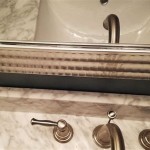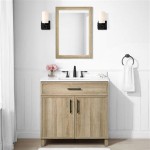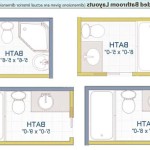Bathroom Ceiling Border Ideas: Enhancing Your Space from Above
The bathroom, often a smaller space within a dwelling, is a critical area for both functionality and comfort. While design efforts frequently concentrate on flooring, cabinetry, and wall treatments, the ceiling is frequently overlooked. However, the ceiling presents a significant opportunity to augment the aesthetic appeal of a bathroom. Incorporating a border around the ceiling’s perimeter can introduce character, visual interest, and a sense of completion to the room. This article explores various bathroom ceiling border ideas, providing guidance on materials, styles, and installation considerations.
Understanding the Purpose and Benefits of Ceiling Borders
Ceiling borders, also referred to as ceiling trim or molding, are decorative elements that frame the meeting point of the walls and ceiling. Their primary function is aesthetic, serving to define the space and create a more polished look. Beyond pure aesthetics, however, ceiling borders offer several practical benefits.
One key benefit is their ability to conceal imperfections. Walls and ceilings often converge with slight irregularities or uneven seams. A properly installed border can effectively mask these flaws, leading to a cleaner and more professional appearance. This is particularly useful in older homes where settling may have caused minor structural shifts.
Furthermore, ceiling borders can visually alter the perception of the room's dimensions. A wide border can make a high ceiling appear slightly lower, creating a cozier and more intimate atmosphere. Conversely, a narrow border can subtly emphasize the height of the ceiling, making the room feel more spacious. The choice of border size and design should therefore be carefully considered in relation to the existing proportions of the bathroom.
Finally, ceiling borders can contribute to the overall design style of the bathroom. They can be chosen to complement existing features such as the vanity, fixtures, and wall coverings. Whether aiming for a classic, contemporary, or rustic aesthetic, the right ceiling border can reinforce the chosen theme and enhance the room's coherence.
Exploring Different Types of Bathroom Ceiling Borders
The market offers a wide array of materials and styles for bathroom ceiling borders, each with its unique characteristics and suitability for different bathroom designs. Selecting the appropriate type requires careful consideration of factors such as moisture resistance, ease of installation, and aesthetic compatibility.
Wood Borders: Traditional wood borders are available in a variety of profiles, from simple square designs to ornate crown moldings. While wood provides a classic and elegant look, it is crucial to select wood that is treated for moisture resistance. Bathrooms are subject to high humidity levels, which can cause untreated wood to warp, crack, or rot. Consider using moisture-resistant woods like cedar or redwood, or opt for wood that has been properly sealed and primed. Regular maintenance, including re-sealing, may be required to prevent moisture damage.
Polyurethane Borders: Polyurethane borders are a popular alternative to wood, offering several advantages. They are lightweight, easy to install, and highly resistant to moisture, making them ideal for bathroom environments. Polyurethane borders are also available in a wide range of styles and finishes, mimicking the look of wood, plaster, or even metal. They can be easily painted to match the existing color scheme of the bathroom, providing flexibility in design. In addition, polyurethane is resistant to insects and mildew, further enhancing its durability and longevity.
PVC Borders: PVC (polyvinyl chloride) borders are another excellent choice for bathrooms due to their exceptional moisture resistance. PVC is completely waterproof, making it impervious to warping, rotting, or mildew growth. PVC borders are also lightweight and easy to cut and install. They are typically available in white or neutral colors and can be painted to customize their appearance. While PVC may not offer the same level of aesthetic appeal as wood or more elaborate polyurethane designs, it is a highly practical and cost-effective option for bathrooms.
Plaster Borders: Plaster borders offer a more traditional and elegant look. They are typically installed by professionals due to the complexity of the installation process. Plaster borders can be molded into intricate designs and provide a seamless, integrated appearance. However, plaster is susceptible to moisture damage and may require special coatings or sealants to protect it in a bathroom environment. Regular maintenance is essential to prevent cracking or crumbling.
Peel-and-Stick Borders: For a simpler and more budget-friendly option, peel-and-stick borders are available in a variety of materials, including vinyl and paper. These borders are easy to install and require no special tools or skills. However, they may not offer the same level of durability or aesthetic appeal as more permanent options. Peel-and-stick borders are best suited for renters or individuals looking for a temporary or easily changeable design element. It is important to ensure the surface is clean and dry before applying the border to ensure proper adhesion.
Design Considerations and Installation Tips
Selecting the right type of bathroom ceiling border is only the first step. Careful consideration of design elements and proper installation techniques are essential to achieving a visually appealing and long-lasting result.
Size and Proportion: The size of the ceiling border should be proportional to the size of the bathroom and the height of the ceiling. In a small bathroom with a low ceiling, a wide border can overwhelm the space and make it feel cramped. A narrow or medium-sized border is typically more appropriate in such cases. Conversely, in a large bathroom with a high ceiling, a wider border can help to define the space and add visual interest. It is advisable to use painter's tape to mock up different border widths on the wall before making a final decision.
Style and Finish: The style and finish of the ceiling border should complement the overall design aesthetic of the bathroom. A modern bathroom may benefit from a simple, clean-lined border, while a traditional bathroom may call for a more ornate crown molding. The finish of the border should also be considered. A painted border can be matched to the wall color or used to introduce a contrasting accent color. A stained or varnished wood border can add warmth and richness to the space.
Color Coordination: Color plays a crucial role in the overall impact of the ceiling border. A border that matches the ceiling color will create a seamless and unified look. A border that contrasts with the ceiling color will draw attention to the border itself and can add a pop of color to the room. Consider the existing color scheme of the bathroom when selecting the color of the border. Using complementary colors or variations of the same color can create a cohesive and harmonious design.
Installation Techniques: Proper installation is essential for ensuring that the ceiling border looks its best and lasts for years to come. Before starting the installation process, carefully measure the perimeter of the ceiling and cut the border pieces to the correct length. Use a miter saw to cut the corners at a 45-degree angle for a seamless fit. Apply construction adhesive to the back of the border pieces and press them firmly against the wall and ceiling. Use finishing nails to secure the border in place until the adhesive dries. Fill any gaps or nail holes with wood filler and sand smooth before painting or finishing. For plaster borders, professional installation is highly recommended to ensure a smooth and seamless finish.
Lighting Considerations: The placement of lighting fixtures should be considered in relation to the ceiling border. Recessed lighting should be positioned so that it does not interfere with the border. Pendant lights or chandeliers can be hung in the center of the room to draw attention to the ceiling and the border. Consider using uplighting to highlight the border and create a soft, ambient glow. The type of lighting used can significantly impact the overall look and feel of the bathroom.
Ventilation: Given the humid environment of a bathroom, proper ventilation is crucial. Ensure that the bathroom is equipped with a properly functioning exhaust fan to remove excess moisture. This will help to prevent the growth of mold and mildew, which can damage the ceiling border and other surfaces in the bathroom. Regularly clean the exhaust fan to ensure that it is operating efficiently. Consider using moisture-resistant materials for the ceiling border and other bathroom elements to minimize the risk of moisture damage.
By carefully considering these design and installation factors, a bathroom ceiling border can be successfully integrated into the space, enhancing its aesthetic appeal and creating a more polished and comfortable environment.

Ceiling Decoration Ideas Diy For Ceilings Addicted 2 Decorating

25 Beautiful Bathroom Ceiling Ideas

68 Crown Molding Ideas And Designs For Any Room In 2024 Bathroom Shower Remodel

25 Beautiful Bathroom Ceiling Ideas

Painting A Bathroom Ceiling And Adding Trim Young House Love

25 Beautiful Bathroom Ceiling Ideas

Custom Border Stencils For Painting Ceiling Designs Wall Borders Modello

Beautiful Bathroom With Sloped Ceiling Over Subway Tiles Accented A Mini Marble Brick Tile Bord Wall Designs Amazing Bathrooms

Bathroom Cladding Trims Everything You Need To Know

Painted Border Ceiling Design Ideas







